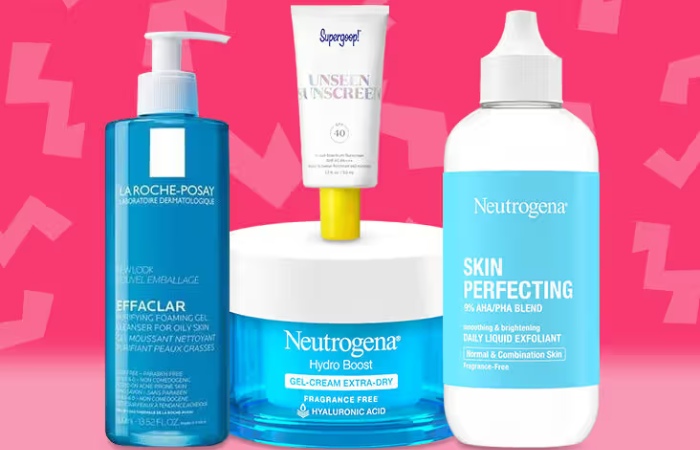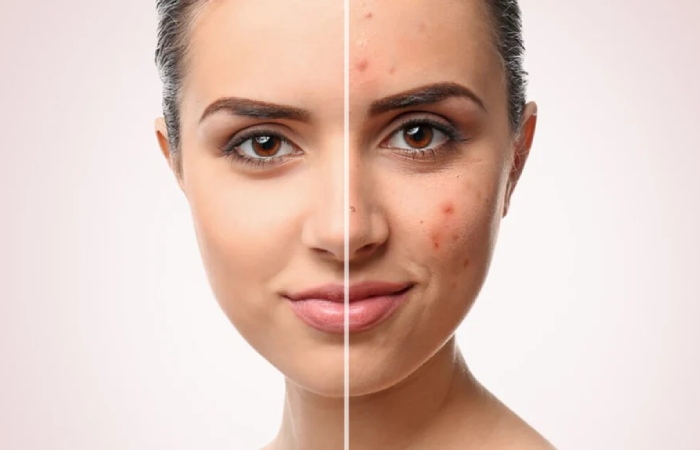Sensitive skin can be unbearable best skincare for sensitive skin. Everything seems to trigger flare-ups, often unexpectedly. Anyone can have subtle skin,” says Dr. Sheila Farhang, a board-certified dermatologist and double-fellowship cosmetic surgeon. “Triggers can be situational or lifestyle-related, such as using boiling water to wash your face or body, over-washing your hands, using harsh ingredients like exfoliants, or being in a dry climate.
This can be frustrating, particularly when combined with other skin conditions like acne or rosacea. Select editorial manager Lauren Swanson was a beauty editor for ages and has dealt with sensitive skin and acne her entire life. “I was stressed when I first got the flare-up, but then the stress triggered inflammation in my sensitive skin. “It was a never-ending cycle.
“If someone has dry, irritated skin, the first thing I would reach for would-be products like those recommended by dermatologists,” Farhang says. These can include products specifically highlighted during a doctor’s visit or even more common over-the-counter products with a dermatologist’s seal of approval. “If the skin doesn’t improve, I recommend scheduling a visit to the dermatologist to rule out other skin conditions, including contact allergies.
Best skin care products for sensitive skin

There are dozens of skincare brands today, many offering products specifically for sensitive skin. Most contain natural ingredients, fewer exfoliants, fragrances, alcohol, sulphates, and preservatives. To help you out, we’ve rounded up some products recommended by experts, highly rated by customers, or recommended by our editorial staff for sensitive skin.
Skincare: Current State Of Play
Skin care products can consist of cosmetics or active ingredients accepted by the Food and Drug Administration (FDA) (this category includes drugs, whether over-the-counter [OTC] or prescription, or even “cosmeceuticals”). Under current FDA regulations, a purely beautifying product or ingredient is defined by its envisioned use. In Chapter VI of the Federal Food, Drug, and Cosmetic Act of 1938, cosmetics are described as “articles intended for application to the human body for purgative, beautifying, promoting attractiveness, or altering the arrival without affecting the structure or function of the body.
In contrast, an FDA-approved OTC covers an “active” ingredient capable of altering the structure or purpose of the skin. The term “cosmeceutical” is a vague marketing term coined by Dr. Albert Kligman, used to label cosmetic ingredients that contain biologically active ingredients. When used over time, combining cosmetic products and over-the-counter medications in a skin care program can produce significant demonstrable benefits.
Because cosmetic products and ingredients have remained largely unregulated, with no requirement for prior FDA approval for marketing (except colour additives), the skin care industry has seen an increase in new ingredients and delivery methods over the past three decades. The growing volume of ingredient monographs exemplifies this added to the International Dictionary and Handbook of Cosmetic Ingredients administered by the Personal Care Products Council.18 Improvements in skin care ingredient technology and advances in delivery and formulation designs have led to the creation of more effective products, fueling the growth of the U.S. skin care industry from $10.7 billion in 2005 to $13.8 billion in 2015.19
Basic Skincare Needs
Protection, prevention, cleansing, and moisturizing are the critical elements of an effective skincare routine. Since most sun damage is due to daily, accidental UV exposure rather than occasional holiday breakouts, dermatologists recommend daily use of sunscreens. Zinc oxide or avobenzone are the most effective active ingredients for blocking both ultraviolet A and ultraviolet B rays. Sunscreens, classified as over-the-counter drugs, must undergo safety and efficacy testing and meet strict labelling requirements.
The FDA has not approved any new sunscreen active ingredients since the 1990s. However, chemistry and formulation technology advances have improved sunscreens’ aesthetics, ease of application, and performance to encourage consumer obedience. Sunscreen should be a mandatory final step in any home skin care regimen.
In general, gel and stick cleansers are best for oily skin, while cream or lotion-based cleansers are best for normal to dry skin. Humectants provide wetting agents that draw water from the environment and the dermis below the stratum corneum. Humectants also include occlusives that act as a fence to transepidermal water loss.
In nearly all cases, products contain both humectants, such as hyaluronic acid, urea, and allantoin, and occlusives, such as petrolatum, mineral oil, and lanolin. Humectants are current in the water phase of a formula; plosives are in the oil phase. Oil-in-water formulations are lightweight gels, lotions, and serums and are best for normal skin dry skin.
Water-in-oil formulations can be ointments or creams, providing superior hydration for dry skin. Recommending the right cleanser, moisturizer, and sunscreen to your patients will be contingent on their skin type, i.e. standard, dry, or oily. The FDA-approved active and functional cosmetic ingredients that patients should look for in their crops will depend on their skin condition, concerns, or primary goals, as described below.
Improving Texture and Tone

The critical attribute of a youthful and healthy complexion is radiance. Radiance is determined by the reflection of light off the skin’s smooth surface. With age, radiance diminishes as the rate of epidermal cell renewal decreases. This leads to the accumulation of dead keratinocytes in the stratum corneum and follicular openings, creating the arrival of rough, dry skin, enlarged pores and poor light reflection.
Exfoliation, whether by chemical or physical means, removes excess corneocyte buildup, which stimulates cell turnover, resulting in a more polished, smoother, and translucent surface. Over the past two decades, exfoliation has gained popularity due to its almost immediate, demonstrable benefits and the ease and variety of products available.
Physical peeling is offered to consumers in a wide range of crops as an alternative to, or in combination with, chemical peeling; these products include topical purgative scrubs containing a variety of solid abrasive particles, mechanical facial brushes, sonication devices, and mildly abrasive cosmetic tools such as micro-exfoliating rollers.
Physical exfoliation induces immediate exfoliation, which in some cases may result in temporary skin barrier disruption, leading to increased transepidermal water loss. 26 These products may not replace the need for professional peels, deep needling, or laser skin treatments, but they may help maintain visible radiance.
Identification (best skincare for sensitive skin)
Skin that is well endangered from extrinsic aging may appear smooth and flawless, but with age, changes in contour, firmness, wrinkles and loss of elasticity are noticeable. Thinning of the skin and dermis due to the decelerating of keratinocyte and fibroblast replication is a manifestation of intrinsic aging, aggravated by extrinsic factors, particularly exposure to ultraviolet rays. The thickness of the epidermis decreases by approximately 6.4% per decade; this is due to a decrease in the number of glycosaminoglycans, hyaluronic acid, collagen and elastin, leading to an overall thinning of the dermis of 6% per decade.
Advances continue to create new vitamin A delivery systems and stabilization techniques that achieve maximum benefit with minimal side effects. One example is retinaldehyde, which requires only a single enzymatic conversion to be metabolized to the active form of vitamin A. Studies have shown that retinaldehyde is well tolerated, resulting in significant improvement in epidermal thickness and activation of markers such as cellular retinoic acid-binding protein type II and keratin, which are also triggered by retinoic acid.29 Other commercially available derivatives are on the horizon, including hydroxypinacolone retinoate, which also promises an effective and easily stood form of retinoic acid.
Managing Sensitivity (best skincare for sensitive skin)
Sensitive skin is a self-diagnosed condition. An estimated 50% of women and 40% of men consider themselves to have sensitive skin to some degree. They describe their skin as extremely reactive, itchy, uncomfortable, red, and dry. This condition is made worse by the environment (UV radiation, temperature, and wind), topical cosmetic and medical products, pollution, stress, and hormones.
When treating a patient with sensitive skin, it is essential to repair and maintain barrier function and reduce inflammation. Barrier repair is best achieved by providing moisture-finished humectants,
such as glycerin and hyaluronic acerbic, and preventing transepidermal water loss through barrier molecules, such as petrolatum and dimethicone best skincare for sensitive skin.
Natural moisturizing factors, lipid complexes, and ceramides reinforce the skin’s barrier function. It is also essential to avoid contact with known irritants, allergens, solvents, surfactants, and preservatives to allow the skin to recover. Topical use of chamomile has been reported to be a beneficial anti-inflammatory ingredient for soothing sensitive skin. Generally, it is advisable to recommend products with limited ingredients.
Maintaining Blemish-free Skin (best skincare for sensitive skin)

Acne is a medicinal condition that undermines a person’s confidence and affects their quality of life. For both teenagers and adults, acne is a stigma. Sufferers are often seen as sickly, unattractive, dirty, and mean. The spectrum of breakouts ranges from occasional blackheads and pimples to extensive, chronic nodulocystic lesions that may leave scars.
To ensure compliance with treatment for mild to moderate adult acne, products should be moisturizing, effective, and cause little to no irritation. Formulas should be aesthetically pleasing, free of medicinal odour, and ideally contain anti-aging ingredients. Sulphur is difficult to tolerate in a leave-on product due to its unpleasant smell. Thus, sulphur masks left on the skin for 10 to 15 minutes before rinsing are a recommended alternative to a leave-on product. Exfoliating cleansers with tiny
grains that mechanically remove dead cells and unclog pores or those containing salicylic acid are good options best skincare for sensitive skin.
Low-concentration benzoyl peroxide (2.5%) is generally adequate for long-term treatment and prevention of breakouts. Retinoids, both prescription and over-the-counter, offer benefits against acne and aging. Since many acne treatment actives, including retinoids and benzoyl peroxide, are mildly sun-sensitizing, daily sunscreen should be used with these ingredients and is especially essential to address concerns about skin aging.
it depends on their fundamental skin type (oily, dry, or combination),
the severity of the condition, and any specific secondary concerns they are looking to address, such as aging, sensitivity, or pigmentation.
Since most patients self-treat their acne,
helping your patients choose an appropriate regimen will improve their overall arrival and increase their satisfaction with the
services you provide. A referral to a board-certified dermatologist is strongly recommended for moderate to severe acne best skincare for sensitive skin.
Creating and Maintaining an Even Skin Tone
A clear, even complexion is a highly valued attribute in many cultures. Hyperpigmentation,
in the form of post-inflammatory brown spots,
melasma, or solar lentigines, increases the insight of an aged appearance more than wrinkles. Subsurface pigmentation makes “dull” skin and a loss of luminosity,
in the identical way particles floating in a lake absorb light,
dulling the light reflection and making the water appear “cloudy” rather than explicit.
A topical medicated home skin care system is a safe, effective, and low-risk alternative or adjunct to rejuvenation procedures. When used daily, a combination of prescription and over-the-counter products containing hydroquinone and retinoids,
exfoliation and sun protection typically results in overall easing of abnormal pigmentation within 8 to 12 weeks. One study concluded that a prescription combination of 4% hydroquinone
and 0.3% retinol was superior to 0.05% tretinoin in improving photoassociated hyperpigmentation.
An even skin tone can be maintained with “lightening” agents that include ingredients such as kojic acid, AHA, licorice root,
and water-soluble vitamin C derivatives, which are found in a variety of products ranging from cleansers to toners and moisturizers. The development of new cosmetic-grade functional lightening agents,
such as hexylresorcinol, pterostilbene, and 1-methylhydantoin-2-imide,
is continuing as beautifying companies seek effective and well-tolerated alternatives to the FDA-approved lightening hydroquinone best skincare for sensitive skin.
Conclusions
As we age, our skin’s inherent anti-aging mechanisms decline:
defences weaken, critical processes slow down, and the rate of degradation of crucial components increases.
Although cosmetic interventions significantly impact aging, such as deep wrinkles,
sagging, and volume loss, they do not necessarily address overall skin quality.
Recommending a home skin care program based on your patient’s individual needs creates synergy with
the services provided by dermatologists and cosmetic surgeons. Clinically proven products,
expressed with the right fixings for specific skin anxiety and delivered in an aesthetically appealing system,
will maximize the outcome and increase the longevity of the benefits of the treatments we offer while allowing the
patient to customize and control their skincare experience best skincare for sensitive skin.


